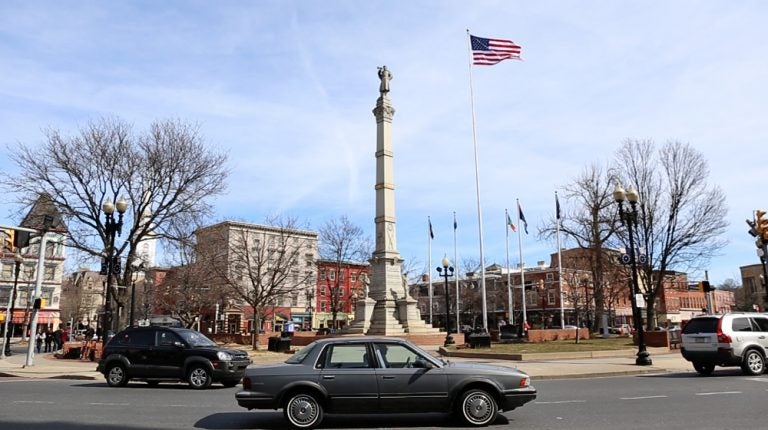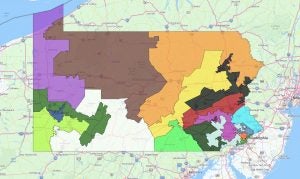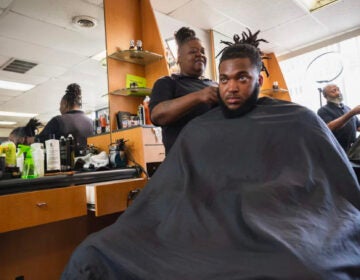In eastern Pa. senate districts, incumbents feel safe, but many voters feel out of the loop

Centre Square in downtown Easton, Pennsylvania. (Lindsay Lazarski/WHYY)
On the eastern border of Pennsylvania, north of the Philadelphia suburbs, a cluster of state Senate districts appear — at first glance — to be arbitrarily drawn.
They twist and tangle their way through Bucks, Lehigh, Montgomery, Northampton, Chester and Monroe Counties.
It’s an area that’s long been a Republican enclave, but has more recently started to lean further left.
But the way the districts are drawn happens to give many Republicans wide margins, while sometimes making things confusing for individual cities and communities.
The 24th Senate District, which has been represented by Republican Bob Mensch since 2009, looks kind of like a sailboat. Or maybe some kind of bird.
Its wide base, which skirts east of Reading through Berks and Montgomery Counties, narrows out into an offshoot that reaches into Bucks, toward the New Jersey border. It rounds off in a shape like a mast, or a beak, facing away from the small city of Easton.
And while it’s one of the area’s more egregiously weirdly-shaped Senate districts, it’s not the only odd one.
Just ask Anthony Marraccini, owner of Connexions art gallery in downtown Easton, and a one-time candidate for the city’s council.
“We all have very odd districts, let’s just be honest,” he said. “If you every look at the districts, they don’t look continuous. They look like, I made up this district because it suits my purposes.”
Marraccini’s liberal home city, with a population of roughly 27,000, is in some ways a perfect example of the politically-motivated line-drawing that has happened in this region over the years.
In 2001, Easton was pulled out of Democratic Senator Lisa Boscola’s 18th district and folded into the 24th —a move Boscola recalled as being intended to make the district harder to represent so its GOP incumbent would retire.
“Easton was forgotten, she said. “They were so used to me being their senator that when people called for help, I just helped them anyway.”
When the maps were redrawn again a decade later, Boscola got Easton back. The rural 24th district, by then represented by Mensch, was reoriented to encompass more farmland.
Easton Mayor Sal Panto, a Democrat, said it was the right move.
“Yeah we were happy, only because Senator Boscola is just more local,” he said.
But he noted, the Republicans controlling the redrawing of the maps also stood to gain for another reason.
“There’s no doubt that politics played some part in this redistricting, because [Boscola’s] district is now more Democratic and [Mensch’s] district is more Republican,” he said.
Although she wholeheartedly approves of Easton’s current position, Boscola said this is something that happens a lot — not always for good reasons. GOP map-drawers stick left-leaning cities into Democratic areas to give themselves wider margins.
It makes Democratic districts safer too, and some of those representatives report being satisfied with how things turn out. But it also sequesters them into smaller areas of influence.
Boscola’s district, for instance, is totally surrounded by Republicans.
“So now in the next redistricting they’re like, ‘well I don’t want that city or borough, give it to her,’ because it’s more democratic. That’s what I’m dealing with,” she said.
“That doesn’t matter, it shouldn’t matter,” she added. “Northampton County should stay as much intact as possible, and these communities of interest should stay intact.”
Senate Republicans declined to comment.
John Kane, business manager for the Philadelphia Plumbers Union, said he felt the impact of this wide-margin-building firsthand.
He ran for state Senate as a Democrat in 2014, aiming to claim the Philadelphia-adjacent 26th District, which is held by Republican Thomas McGarrigle.
But he said the odds against him — or maybe any member of his party — were too high.
“The district was gerrymandered to bring in two towns from Chester County, which was Willistown and Easttown — predominantly Republican areas,” he said. “Do I believe I could have won without those in there? Absolutely.”
Boscola said the practice of moving cities around to keep seats safe also has a more practical shortfall.
Using Easton as an example, she said for the people who live there, it’s just disorienting — and can lead to disengagement.
“The people there were so confused, like anybody would be. One minute you’re in the 18th, then you’re out, now you’re back in,” she said. “That’s the danger of putting this in the hands of political leaders that draw these maps. Because there’s always shenanigans going on.”
Talking to a random selection of people in Easton, that does seem like it could be the case.
Many didn’t know who their senator was, but recognized names of a few in the area. Others were totally lost.
Of course, that could just be run-of-the-mill lack of engagement.
But Anthony Marraccini, the gallery owner who ran for city council, said he thinks even that is rooted in the sense that people don’t really control their state government representation — that they’re resigned to whatever party has institutional control.
“There’s apathy. There’s indifference. And then there’s just — what the hell are you supposed to do about it?” he said. “How do you change that? The party has to decide it wants to change.”
He added, he thinks if so many districts keep staying as safe for incumbents as they are right now, it’s hard to see what reason people have to ever pay attention.
WHYY is your source for fact-based, in-depth journalism and information. As a nonprofit organization, we rely on financial support from readers like you. Please give today.






